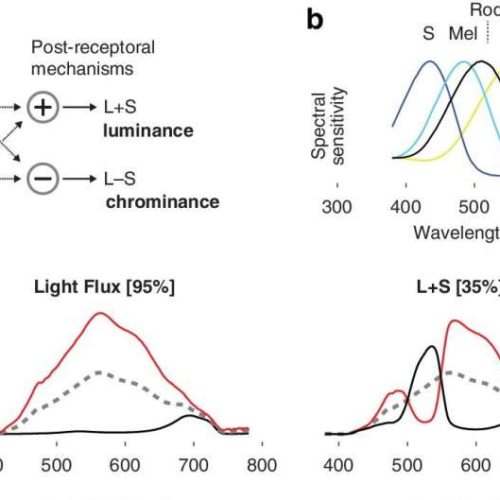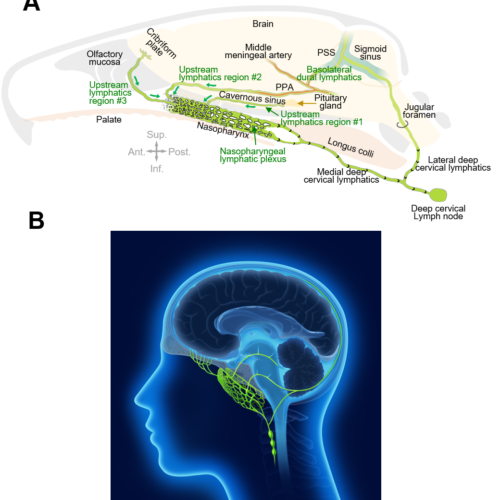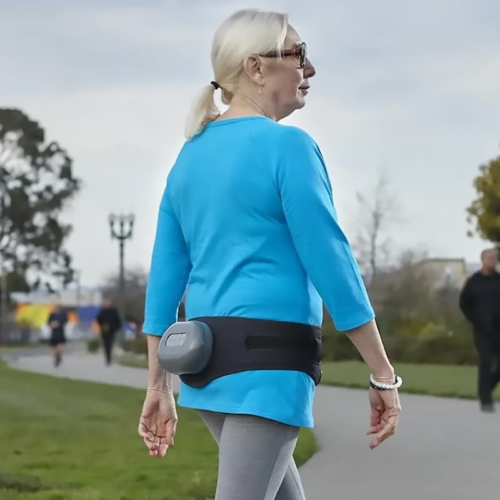by University of Pennsylvania (a) Signals from the L/M (hereafter “L”) and S cones are combined and contrasted to create two postretinal channels that signal luminance and chrominance. (b) Spectral sensitivities of the canine photoreceptors. (c) Stimulus spectra used to target particular photoreceptor combinations. Each stimulus modulated between a stimulating (red) and suppressing (black) spectrum around...
Brain Drain – Nasopharyngeal Lymphatics Found to be Crucial for Cerebrospinal Fluid Outflow
‘Lymphatic plexus’ behind the nose drains cerebrospinal fluid from the brain, potentially impacting neurodegenerative conditions – In a groundbreaking study published in Nature, South Korean researchers led by Director KOH Gou Young of the Center for Vascular Research within the Institute for Basic Science (IBS) have uncovered a distinctive network of lymphatic vessels at the...
CSF Cerebrospinal Fluid
IntroductionCerebrospinal fluid (CSF) is a clear, plasma-like fluid (an ultrafiltrate of plasma) that bathes the central nervous system (CNS). It occupies the central spinal canal, the ventricular system, and the subarachnoid space. Image 1 shows a 3D image of the CSF circulation as it would look inside the skull. CSF performs vital functions including: Support;...
FDA clearance of first prescription wearable to treat low bone density
By Paul McClure Osteoboost, a wearable device that delivers vibrations to the hips and spine to treat low bone density, has become the first medical device of its type to receive FDA clearance Bone Health Technologies The FDA has granted clearance to a wearable belt that delivers targeted vibrations to the spine and hips as...
‘Subtle Changes’ to the 2024 ADA Standards of Care in Diabetes
Anne L. Peters, MD The new American Diabetes Association Standards of Care-2024 is a really interesting, updated document. There aren’t any huge headlines, but there are many subtle changes. I think it’s important that people really understand what the guidelines say and how we can apply this to patients. The guidelines are long. There are...
Why Do GLP-1 Drugs Stop Working, and What to Do About It?
There’s no question that glucagon-like peptide 1 (GLP-1) agonists represent a major advance in the treatment of obesity for patients with or without diabetes. In clinical trials, participants lost 15%-20% of their body weight, depending on the drug. But studies also have shown that once people stop taking these drugs — either by choice, because...
Direct Measurement of T3 Is Likely Vital, Say Researchers
Marlene Busko To assess thyroid function, clinicians typically determine blood levels of thyroid-stimulating hormone (TSH) and thyroxine (T4) and do not directly measure triiodothyronine (T3). However, findings from a large observational study of a US sample of adults with normal thyroid function suggested that subclinical variation in the hypothalamic-pituitary-thyroid (HPT)–axis effector hormone T3 “is an...
COVID, No Matter the Severity, Linked With Urologic Effects in Men
Marcia Frellick SARS-CoV-2 infection is linked in men with increased incidence of urinary retention, urinary tract infection (UTI), and blood in the urine, a new study finds. Authors of the study, led by Alex Qinyang Liu, of S.H. Ho Urology Centre, at The Chinese University of Hong Kong, highlighted the clinical implications. “Clinicians should be...
CMS Okays Payment for Novel AI Prostate Test
Howard Wolinsky Editor’s note: An earlier version of this story erroneously stated that Medicare has started covering use of the AI-based cancer test. Neither the company nor CMS provided Medscape with information on how much the payment will be should the agency agree to cover the test. Medicare has set a payment rate for an...
Ascidian’s lab in Boston is developing a new kind of RNA editing therapy
First-ever RNA editing trial in US gets clearance, pitting ‘exon editing’ technology against vision lossRyan CrossSenior Science CorrespondentThe FDA told the Boston startup Ascidian Therapeutics that it can begin the first clinical tests of a therapy that “rewrites” RNA to correct roughly two-thirds of the genetic typos responsible for an inherited form of vision loss...





